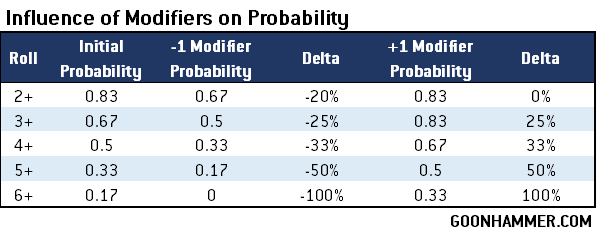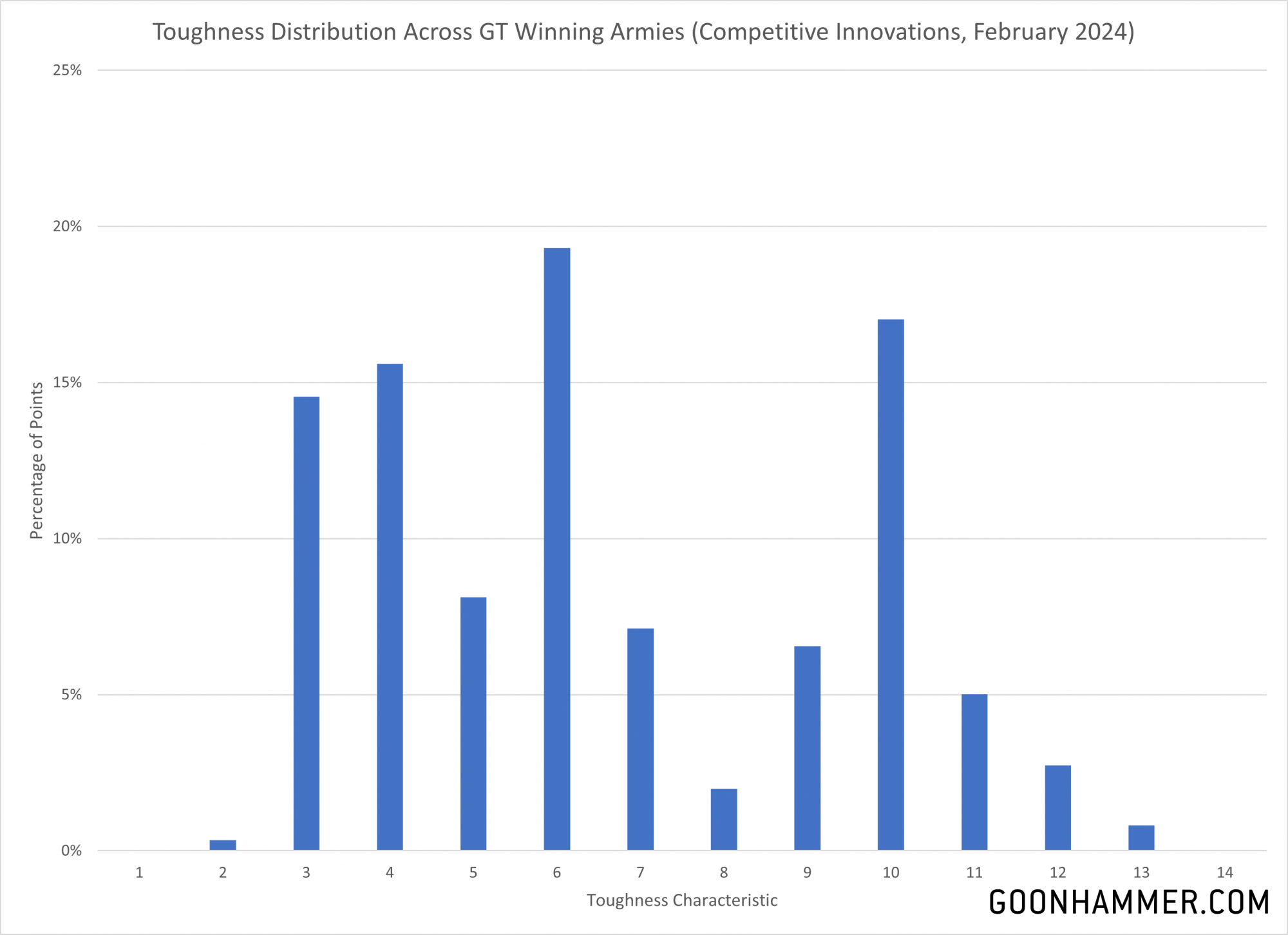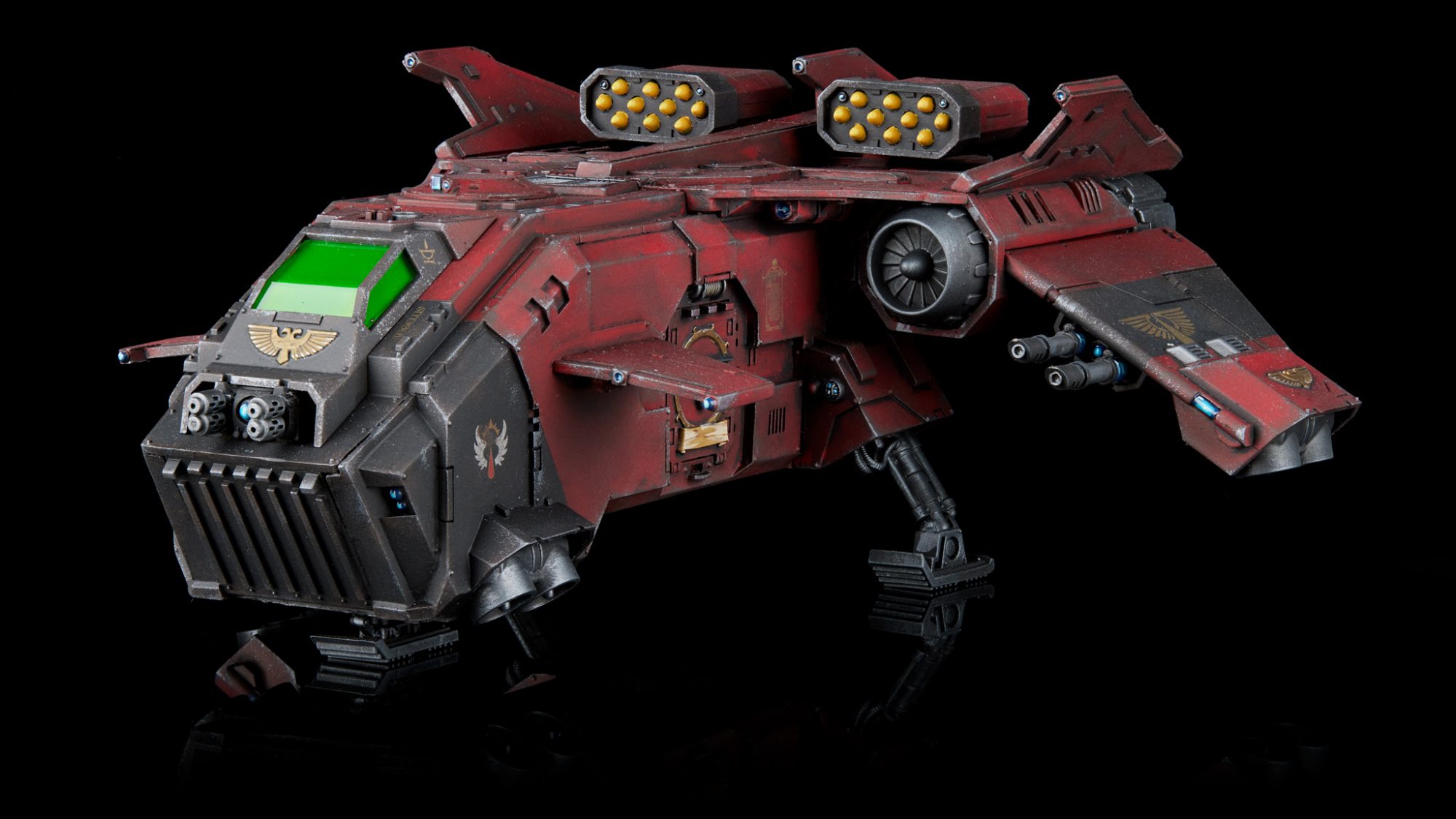This week’s Hammer of Math takes a more holistic look at the datasheets of Warhammer 40k and tries to get a sense of how Toughness characteristics are distributed.
Most modifiers are easy to understand and translate to an impact on the battlefield. A bonus to hit, wound, or save is a direct improvement based on the existing probability. The chart below is one that’s been conveniently true for as long as gamers have been rolling six-sided dice. Whether the change is from a Hit roll bonus, [LANCE] weapon on the charge, or Armour Penetraton stat, the result is static and evident:
 Unfortunately there’s one area where GW continues to makes things a bit more complicated, and that’s in how some abilities modify the Strength characteristic of the attack instead of a fixed modifier to the wound roll. The Wound roll target is a function of the relationship between the attack Strength characteristic and the target Toughness characteristic, so minor changes can either provide the equivalent of a +1 bonus or do nothing at all. In the recent Balance Dataslate GW went so far as to give Blood Angels a +2 bonus to their Strength characteristic on the charge, opening up the possibility of getting a modifier to the Wound roll that is actually better than the traditional +1 modifier.
Unfortunately there’s one area where GW continues to makes things a bit more complicated, and that’s in how some abilities modify the Strength characteristic of the attack instead of a fixed modifier to the wound roll. The Wound roll target is a function of the relationship between the attack Strength characteristic and the target Toughness characteristic, so minor changes can either provide the equivalent of a +1 bonus or do nothing at all. In the recent Balance Dataslate GW went so far as to give Blood Angels a +2 bonus to their Strength characteristic on the charge, opening up the possibility of getting a modifier to the Wound roll that is actually better than the traditional +1 modifier.

Figuring out the distribution of Toughness characteristics has always been something I have wanted to do, but it’s a very labor intensive process and figuring out the best way to present the data is a challenge. I suspect that this is going to take a lot more introspection, but as a starting point I decided to look at exemplary work that James Grover has done for Competitive Innovations and look at the distribution of all the GT winning lists. The process was pretty simple.
- Read every list from the CI series through February.
- Capture the Toughness characteristic and percentage of points made for unit.
- Bin the distribution and chart it.
So I did just that. 507 entries, 49 lists, one Sunday evening. The results are below.
 Now it’s important to note that this is not a complete picture of the Warhammer 40k game environment. The factions are heavily skewed towards the top tier of competitive lists, which means armies like Imperial Knights and Thousand Sons don’t get any visibility. As one might expect, a lot of Space Marines in loyalist and heretical forms are included. I hope to continue to explore this in the future, but for now there are a few things we can certainly glean from the initial data.
Now it’s important to note that this is not a complete picture of the Warhammer 40k game environment. The factions are heavily skewed towards the top tier of competitive lists, which means armies like Imperial Knights and Thousand Sons don’t get any visibility. As one might expect, a lot of Space Marines in loyalist and heretical forms are included. I hope to continue to explore this in the future, but for now there are a few things we can certainly glean from the initial data.
- The four most prevalent Toughness characteristics were 10, 6, 4, and 3, with two thirds of the points spent on units in these lists allocated to those values. T6 was the most popular with 19% of the points allocated.
- Applying a +2S bonus to a S4 model improves the wound roll against 43% of the units (by points) featured in the competitive articles.
- Once a major breakpoint for weapons and armor, T8 has become an absolute wasteland, with only 2% of the total points of competitive lists featuring units with that Toughness characteristic. With heavy platforms going to T12 and lighter vehicles hanging around at T10 the fabled power fist doesn’t do much beyond punch holes in power armour.
- The valley between T6 and T10 shows the pitfalls of just adding +1S to a weapon, as going from S7 to S8 is not terribly helpful outside of pasting Intercessors. +2S at least lets power fists and thunder hammers have a decent chance against a T10 target.

Wrapping Up
We’ll revisit this topic in the future with more data, but the core takeaway is that 10th Edition 40k has a significant gap in competitive units between T7 and T9, which makes abilities which improve Strength highly subjective depending on the target. Given the Strength characteristic of many Space Marine units the +2S bonus given to Blood Angels is actually particularly notable, with S4 units getting a boost against a lot of infantry threats and S8 now viable against T10 when charging.
It’s also worth noting that T3 was a popular value here as the toughness on infantry units in Astra Militarum, Drukhari, Aeldari, and Adepta Sororitas lists, and adding +2 S to a S4 marine unit also improves the wound roll against those to a 2+.
So when is +2 Strength better than +1 to wound? For the most part, they’re the same against most of the targets you’d come up against. The answer here is “when your weapon strength is exactly one less than the target’s toughness,” as it pushes you from a 5+ to wound to a 3+ to wound. There aren’t that many T5 targets in the game – though Plague Marines say “hi” here before they lob a pair of grenades – so we’re looking for S5 melee weapons which can then take down those T6 targets. And the answer to that question is power weapons and encarmine blades – these hit at S5, and so are able to go to S7 against T6 targets, giving them more value in a Blood Angels army. There’s also some marginal additional value on Thunder Hammers and Power Fists, where going from S8 to S10 will help you against the uncommon but not rare set of T9 targets like Rhinos.
This means the big winners of the dataslate update are Sanguinary Guard, who suddenly look much better against T5 and T6 targets with S5 weapons on the charge, and Death Company marines, who can take large numbers of power weapons. Now whether those are worth building around is a different story.
Thanks for reading! If you have any questions or comments feel free to drop us a note in the Comments below or email us at contact@goonhammer.com. That’s also the best way to suggest topics for future articles. And if you want regular updates in your inbox, subscribe to our newsletter.


